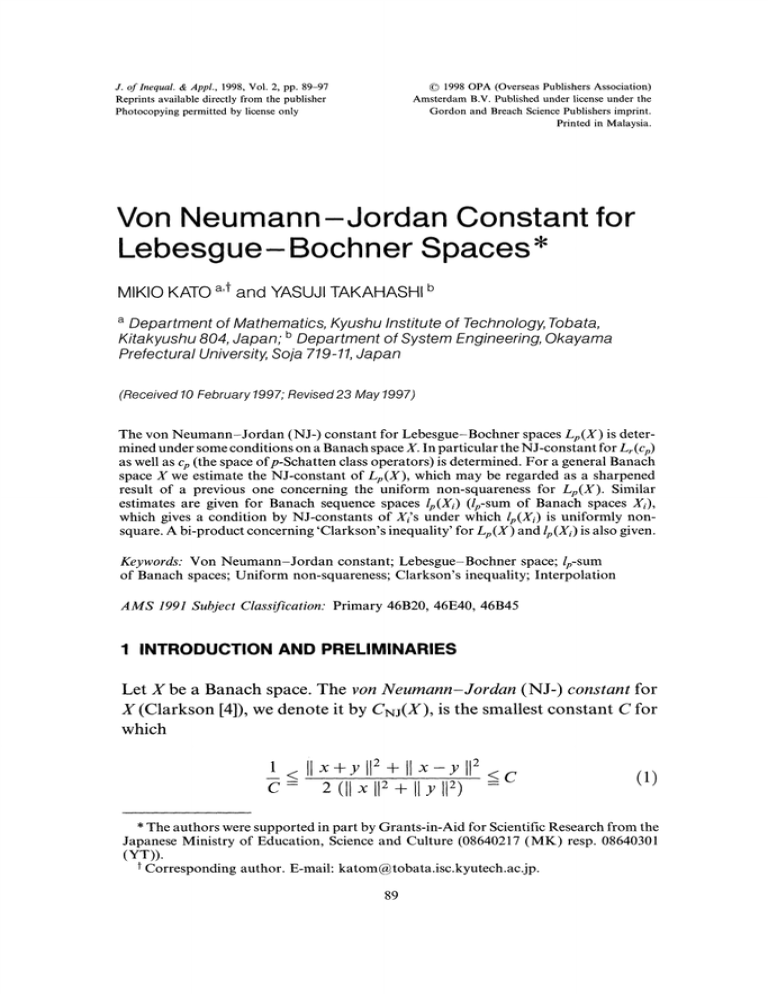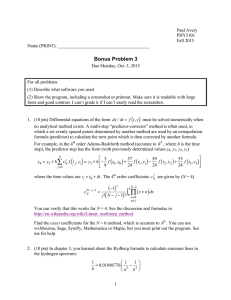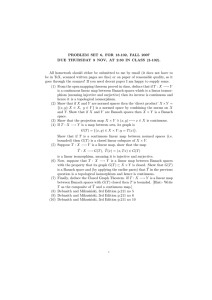Document 10943892
advertisement

(C) 1998 OPA (Overseas Publishers Association)
Amsterdam B.V. Published under license under the
Gordon and Breach Science Publishers imprint.
Printed in Malaysia.
J. of lnequal. & Appl., 1998, Vol. 2, pp. 89-97
Reprints available directly from the publisher
Photocopying permitted by license only
Von Neumann-Jordan Constant for
Lebesgue-Bochner Spaces*
MIKIO KATO a,t- and YASUJI TAKAHASHI b
a
Department of Mathematics, Kyushu Institute of Technology, Tobata,
Kitakyushu 804, Japan; b Department of System Engineering, Okayama
Prefectural University, Soja 719-11, Japan
(Received 10 February 1997; Revised 23 May 1997)
The yon Neumann-Jordan (NJ-) constant for Lebesgue-Bochner spaces Lp(X) is determined under some conditions on a Banach space X. In particular the NJ-constant for Lr(cp)
as well as Cp (the space ofp-Schatten class operators) is determined. For a general Banach
space X we estimate the NJ-constant of Lp(X), which may be regarded as a sharpened
result of a previous one concerning the uniform non-squareness for Lp(X). Similar
estimates are given for Banach sequence spaces lp(Xi) (/p-SUm of Banach spaces Xi),
which gives a condition by NJ-constants of Xi’s under which lp(Xi) is uniformly nonsquare. A bi-product concerning ’Clarkson’s inequality’ for Lp(X) and lp(Xi) is also given.
Keywords: Von Neumann-Jordan constant; Lebesgue-Bochner space;/p-SUm
of Banach spaces; Uniform non-squareness; Clarkson’s inequality; Interpolation
AMS 1991 Subject Classification: Primary 46B20, 46E40, 46B45
1 INTRODUCTION AND PRELIMINARIES
Let X be a Banach space. The yon Neumann-Jordan (NJ-) constant for
X (Clarkson [4]), we denote it by CNj(X), is the smallest constant C for
which
2
< x +y 2+ x-y
C
2 (11 x + y 2)
2
<C
* The authors were supported in part by Grants-in-Aid for Scientific Research from the
Japanese Ministry of Education, Science and Culture (08640217 (MK) resp. 08640301
(YT)).
Corresponding author. E-mail: katom@tobata.isc.kyutech.ac.jp.
89
90
M. KATO AND Y. TAKAHASHI
holds for all x and y in X with (x, y) (0, 0). A classical result of Jordan
and von Neumann [8] implies that _<_ Cyj(X)_<_ 2 for any Banach
space X; and X is a Hilbert space if and only if Cyj(X)- 1. Clarkson
[4] showed that Cyj(Lp)-22/min{p’p’}-l, lip + lip’- 1. Recently Kato
and Miyazaki [10,9] determined the NJ-constant for Lp(Lq) (Lq-valued
Lp-space), Sobolev spaces Wp(ft) [10], and for Cc(g) (the space
of continuous functions with compact support on a locally compact
Hausdorff space K; [9]). On the other hand, the authors [11,19] gave a
sequence of new results about the NJ-constant. In particular they
showed that: (i) X is super-reflexive if and only if X admits an
equivalent norm with NJ-constant less than 2 [11]; this was refined as
(ii) X is uniformly non-square if and only if Cyj(X) < 2 [19].
In this note we first state Clarkson’s procedure to obtain the NJconstant of Lp [4] in a generalized setting, and then we determine the NJconstant for Lebesgue-Bochner spaces Lp(X) under some conditions
on a Banach space X. As corollaries the NJ-constant for L,(Cp) as well as
Cp (the space ofp-Schatten class operators) is determined, and the results
in [4,9,10] stated above are also obtained. Next, we estimate Cyj
(Lp(X)) for a general Banach space X, which is best possible in several
cases. Previous results on uniform non-squareness (Smith and Turett
[17]) and super-reflexivity (Pisier [15]) for Lp(X) are obtained as immediate consequences. Similar estimates are also given for Banach
sequence spaces lp(Xi) (/p-SUm of Banach spaces Xi), which implies in
particular that lp(Xi) is uniformly non-square if and only if sup Cyj
(Xi) < 2. As a bi-product it is derived that ’Clarkson’s inequality’ holds
in Lp(X), resp. in lp(Xi) if and only if it holds in X, resp. in each Xi (for
the former, see Kato and Takahashi [12]).
Let X be a Banach space and let __<p < oe. Let Lp(X) be the
Lebesgue-Bochner space on an arbitrary measure space (S, #), that is,
the space of all (equivalence classes of) X-valued #-measurable
functions f on S such that Ilfllz(x.-{fsllf(.)llpxd} /p (resp.
eSSsSUp IIf(’)llx) for __< p < oc (resp. p- ec) is finite. For X- K (reals
or complexes) Lp(K) is denoted by Lp as usual. The Banach sequence
space lp(Xi) is the/p-SUm of Banach spaces Xi’s, that is, the space of
all sequences x= {xi} with xi Xi and [IX[Ip { -/__ [Ixil[ p } /p < oc (el.
e.g., [161).
A Banach space X is called (2,)-convex, e>0, provided
min{l[x +yl], I[x-yl[} 2(l-e) whenever [[x[I _< 1, [[Y[I -< (cf. [20,51).
<=
VON NEUMANN-JORDAN CONSTANT
91
X is called uniformly non-square if it is (2, e)-convex for some e > 0 ([6];
cf. [1]). X is said to be super-reflexive ([7]; cf. [1,20])if any Banach space
which is finitely representable in X is reflexive (a Banach space Y is said
to be finitely representable in X when any finite-dimensional subspace
of Y can be found in X, with an approximation as good as one wants).
It is well known that uniformly convex spaces are uniformly nonsquare, and uniformly non-square spaces are super-reflexive; superreflexive spaces are just those uniformly convexifiable (cf. [1,7,20]).
Let
,
Let 12(X), 1<= r
denote the X-valued/r2-Space. In the following,
pr, qr, r,.., denote the conjugate numbers of p, q, r,...
2 VON NEUMANN-JORDAN CONSTANT FOR
Lp(X)
We start with the following lemma.
LEMMA
Let < < 2.
(i) Cyj(X)- 22/t-1 if and only if
IIA"/22(X)
21/t;
(2)
and hence CNj(X’)= CNj(X) (X’ is the dual space of X).
(ii) If X contains a nearly isometric copy of l2t or 12t, (in particular if lt or
lt, is finitely representable in X), then Cyj(X)_>_ 22/t-1.
Proof (i)
is readily seen by noting that the first and second inequalities in (1) are equivalent; put x + y- u, x-y v.
(ii) Assume that for any A > there exists a two-dimensional subspace
X0 of X and an isomorphism T from It2 onto X0 such that
Ilxll
Txll
ltxl[ for all x E It2.
M. KATO AND Y. TAKAHASHI
92
It2
IIx + yll 2 + IIx
Then for any x, y in
yl[ 2
2([Ixll + Ily[I 2)
/4CNJ (X),
whence CNj(/t2) <--_/4CNJ(X ). Letting A--+ 1, we have the conclusion
because CNj(/t2) CNj(/t2,) 2 2/t-1 ([4]; see also [10]).
Clarkson’s procedure to determine the NJ-constant for Lp [4] is
stated in a generalized setting as follows.
<=
PROPOSITION 2 Let
(t, t’) Clarkson inequality
(llx + yll" + IIx
<___ 2
and let l/t+ lit’= 1. Assume that the
yllt’) 1/t’ 21/t’ (llxll’ + II.vII’) 1/’
holds in X, and X contains a nearly isometric copy
CNj (X)-- 22/t- 1.
of 12t
or
(3)
12t,.
Then
Proof By (3) we have
IIA" Z22(X) Z(X)II
<_ 21/t-1/221/t’ 21/2-1/t
21/t,
(4)
where /’s are identity operators. This implies CNj(X)2 2/t-1. The
opposite inequality follows from Lemma (ii).
Remark 3 In any Banach space some (t,t ) Clarkson inequality,
<__ _<_ 2, holds. Indeed, as is easily seen, (1, ec) Clarkson inequality is
valid in any Banach space; and if <__s<t<=2, (t,t’) Clarkson
inequality implies (s,s’) inequality [18]. For some examples of Banach
spaces in which (t, ) Clarkson inequality holds with > we refer the
reader to [14].
By Proposition 2 we immediately obtain the NJ-constant for Cp as
well as some previous results.
COROLLARY 4 (i) Let _< p <__ o. Let min{p,p’ }. Then for X= Lp
(Clarkson [4]), Wp(f) (Kato and miyazaki [10]), and Cp, CNj(X)
22/t -1.
VON NEUMANN-JORDAN CONSTANT
93
(ii) CNj(Cc(K))= 2 (Kato and Miyazaki [9]).
Indeed, in Cp, the (t,t’) Clarkson inequality holds and lp is isometrically imbedded into Cp (McCarthy [13]; cf. [14]).
LEMMA 5 (Takahashi and Kato [18; Theorem 2.3]) Let <__p<=cx
and let <__
2. Assume that the (t, t’) Clarkson inequality (3) holds
in X. Then (s,s’) Clarkson inequality holds in Lp(X), where s=
<=
min{t,p,p}.
THEOREM 6 Let < p <__ oe and
Clarkson inequality (3) holds in X.
<=
<__ 2.
Assume that the (t, t’)
<=
<=
or t’ <__p < ec, then CNj(Lp(X))-- 22 where r=
(i) If <_p
min{p,p’}.
(ii) If <__ p t’, and if X contains a nearly isometric copy of l2t or lZt,, then
CNj(Lp(X))-- 22/t- 1.
Proof (i) By Lemma 5 (r,r’) Clarkson inequality holds in Lp(X).
Since lp2 is isometrically imbedded into Lp(X), we have CNj(Lp(X))--
2z/r-1 by Proposition 2.
(ii) In this case (t,t’) Clarkson inequality holds in Lp(X) by
Lemma 5. Since X, and a fortiori Lp(X), is supposed to contain a
nearly isometric copy of It2 or lt2,, we have the conclusion.
By Theorem 6 we obtain the following.
COROLLARY 7 Let
<=p, q <__
.
Let
min{p, q,p’, q’}. Then
(i) CNJ(Lp(Cq) 22/t-1
(ii) CNj(Lp(Lq))-- 22/t-; (Kato and miyazaki [10]).
Next we estimate the NJ-constant of Lp(X) with a general X (and
also that of lp(Xi)).
LEMMA 8 Let
space X
(i)
(ii)
<= p <__ 2 and let 1/p 4- 1/p’
2
][A lp(Lp(X))
IIA" l(lp(Xi))
-
1. Then for any Banach
2
[[A .12p(X) lp,2 (X’)[[,
lp,(Lp(X))[[
2
lp,2 (lp()(i))l[ sup/I[A’12p(Xi) ---+ lp,(Xi)[}.
_.+
M. KATO AND Y. TAKAHASHI
94
us see the inequality ’_<’ (the converse inequality is
trivial). For any f and g in Lp(X) we have
Proof (i) Let
]If+ g[l’p(x) + Ilf- g[lPL’p(X)
p’/p
-{: Ilf(t)+g(t)llPd#(t))
d#(t))P’/P
(: (,If(t)+ g(t),,P’+,lf(t) g(t)llP’)
p/p<= 1)
<-_ I[A lp2(X) lp,2 (X)IIP’ {:. (llf(t)ll
p) d/z(t)
<
P’/P
p/p’
by Minkowski’s inequality for
p
IlA lp(x)
/
__
IIg(t)ll
’(
lp,(X)[I p Ilfl pL.<X> / g"IILp(X)
which gives the conclusion. The proof of (ii) goes in the same way.
THZORZM 9 Let
<p < cx, and let t-min{p,p’}.
max{CNj(Lp), CNj(X)} CNj(Lp(X))
Then
CNj(tp) CNj(X) 2It’, (5)
where 1/p + 1/p’- 1/t + lit’- 1.
Here one should note that CNJ(Lp)= 2 2/t-1, and hence the third term
in (5) is not bigger than 2.
The left-hand inequality of (5) is trivial since Lp and X are
isometrically imbedded into Lp(X). We prove the right-hand inequality
of (5). Let <p 2. Let CNj(X)--2 2/r-,
r 2. Then by Lemma
Proof
=<
<= =<
IIA .12(X) --+/22(X)11
21/r.
(2)
1.
(6)
On the other hand, we obviously have
IIA’Z(X)
Z2(X)II
Put 0-2/p’ (0 < 0 < 1). Then by interpolation (cf. [2], esp. Theorems
5.1.2, 4.2.1 and 4.1.2) with (6) and (2), we have
[iA.lpZ(X
__+
.,2 (x)ll < 1’-2/- 22/p’r,
VON NEUMANN-JORDAN CONSTANT
95
from which it follows that
IIA lp2(Lp(X)
-
lp,2 (Lp(X))] < 22/p’r
by Lemma 8 (i). Therefore, in the same way as (4), we obtain
-
IIA (p(X)) 2(p(X)) -< 21/p-1/p’+z/p’r.
=<
Put here 1/s- l/p-lip’ + 2/p’r (note that
s __<p __< 2). Then we have
:/s-1 2 z/p-1 + 2(2/r--1)/p’
2
Lemma
by
1, which implies the
CNj(Lp(X)) <right-hand inequality of (5). Let next 2 < p < oc and let CNj(X) < 2 (the
right-hand inequality of (5) is trivial if p-o or CNj(X)- 2). Then X
is reflexive by Theorem 6 in [11] (or Theorem 8 in [19]) and hence X’
has the Radon-Nikodym property; therefore Lp(X)’-Lp,(X’).
Consequently we obtain the conclusion by Lemma and the preceding
case.
Remark 10 Both inequalities of (5) in Theorem 9 are reduced to
equality in the following cases; that is, we have:
(i) If CNj(X 1, then Cj(Lp(X))- Cyj(Lp).
(ii) If CNj(X ) 2, then Cyj(Lp(X))- Cyj(X).
(iii) If p 2, then CNj(L2(X)) CNj(J() for all X.
Recall here the authors’ results in [19,11] which state that X is
uniformly non-square if and only if CNj(X)< 2 [19]; and X is superreflexive if and only if X admits an equivalent norm with NJ-constant
less than 2 [11]. Now, Theorem 9 implies that for <p<
CNj(Lp(X)) ( 2 if and only if CNj(X ( 2. Therefore we immediately
obtain the following well-known facts:
COROLLARY 11 Let < p < o.
(i) Lp(X) is uniformly non-square if and only if X is (Smith and Turett
[17]).
(ii) Lp(X) is super-reflexive if and only if X is (Pisier [15]).
Similar estimates as
(5) in Theorem 9 are valid for lp(Xi).
M. KATO AND Y. TAKAHASHI
96
THFO,EM 12
Let
<__p < oc and let t-min{p,p}.
Then
max{CNj(lp), sup CNj(Xi) } <- Cyj(lp(Xi))
<= CNj(lp)
Sup Cyj(Xi) 2/t’.
(7)
The proof goes in the same way as that of Theorem 9 by using
Lemma 8 (ii).
Remark 13 In inequalities (7), equality is simultaneously attained in
the cases where (i) sup Cyj(Xi)- or 2, and (ii) p- 2.
Now, uniform non-squareness dose not lift to lp(Xi) from Xi’s in
general (see [16], esp. p. 152). Giesy [5; Corollary 18] gave the following
condition under which this is the case: If Xi is (2, e)-convex and if
infei> 0, then lp(Xi) is uniformly non-square. Our next result might
provide a far simple condition which assures the uniform nonsquareness of lp(Xi). By Theorem 12, combined with the authors’
result in [19] stated above, we obtain:
COROLLARY 14 Let < p < ec. Then lp(Xi) is uniformly non-square if
and only if sup CNj (Xi) < 2.
Finally we see that Lemma 8 yields a bi-product concerning the (t, )
Clarkson inequality (1 _< < 2)
([ix + yllt’ + x
yllt’)l/t’<= 21/t (llxl] + []y[l)l/.
(3)
Since equality is always attained in (3) (put y- 0), the inequality (3) is
represented as
IIA- z(x) z,,(x)ll
21/’’.
Therefore (3) holds in X if and only if it does in the dual space X’ ([11,
Theorem 3]). Lemma 8 and these observations lead us to the following
theorem.
THEOREM 15 Let
<= p <= cx and t- min{p,p’}. Then:
(i) (t, t’) Clarkson inequality holds in Lp(X) if and only if it holds in X
p 2; cf. Lemma 5).
([12, Theorem 4] for the case
Clarkson
holds
in lp(Xi) if and only if it holds in
inequality
(ii) (t, t’)
each Xi.
<= <=
VON NEUMANN-JORDAN CONSTANT
97
References
[1] B. Beauzamy, Introduction to Banach Spaces and their Geometry, 2nd edn., North
Holland, Amsterdam-New York-Oxford, 1985.
[2] J. Bergh and J. L6fstr6m, Interpolation Spaces, Springer-Verlag, Berlin-HeidelbergNew York, 1976.
[3] J. A. Clarkson, Uniformy convex spaces, Trans. Amer. Math. So., 41) (1936)
396-414.
[4] J. A. Clarkson, The von Neumann-Jordan constant for the Lebesgue space, Ann. of
Math., 38 (1937) 114-115.
[5] D. P. Giesy, On a convexity condition in normed linear spaces, Trans. Amer. Math.
Soc., 125 (1966) 114-146.
[6] R. C. James, Uniformly non-square Banach spaces, Ann. of Math., 81) (1964)
542-550.
[7] R. C. James, Super-reflexive Banach spaces, Canad. J. Math., 24 (1972) 896-904.
[8] P. Jordan and J. von Neumann, On inner products in linear metric spaces, Ann. of
Math., 36 (1935) 719-723.
[9] M. Kato and K. Miyazaki, Remark on generalized Clarkson’s inequalities for
extreme cases, Bull. Kyushu Inst. Tech. Math. Natur. Sci., 41 (1994) 27-31.
[10] M. Kato and K. Miyazaki, On generalized Clarkson’s inequalities for Lp(#; Lq(l,,))
and Sobolev spaces, Math. Japon., 43 (1996) 505-515.
[11] M. Kato and Y. Takahashi, On the von Neumann-Jordan constant for Banach
spaces, Proc. Amer. Math. Soc., 125 (1997) 1055-1062.
[12] M. Kato and Y. Takahashi, Type, cotype constants and Clarkson’s inequalities for
Banach spaces, Math. Nachr., to appear.
[13] C. McCarthy, Cp, Israel J. Math., 5 (1967) 249-271.
[14] D. S. Mitrinovi6, J. E. Peari6 and A. M. Fink, Classical and New Inequalities
in
Analysis, Kluwer Academic Publishers, Dordrecht-Boston-London, 1993.
[15] G. Pisier, Martingales with values in uniformly convex spaces, Israel J. Math., 2t)
(1975) 326-350.
[16] M. A. Smith, Rotundity and extremity in lP(Xi) and LP(I,X), Geometry of Normed
Linear Spaces, Contemporary Math., Vol. 52, Amer. Math. Soc., ProvidenceRhode Island, 1986, pp. 143-162.
[17] M. A. Smith and B. Turett, Rotundity in Lebesgue-Bochner function spaces, Trans.
Amer. Math. Soc., 257 (1980) 105-118.
[18] Y. Takahashi and M. Kato, Clarkson and random Clarkson inequalities for Lr(X),
Math. Nachr., to appear.
[19] Y. Takahashi and M. Kato, Von Neumann-Jordan constant and uniformly nonsquare Banach spaces, preprint.
[20] W. A. Wojczynski, Geometry and martingales in Banach spaces, part II. In:
Probability on Banach Spaces 4 (Kuelbs, Ed., Marcel Dekker, 1978), pp. 267-517.


